Novel reseach tools for Lipid peroxidation (LPO) LipiRADICAL™ Green / OH-Pen
Date:December 20 2020Web Page No:95008

Funakoshi Co.,Ltd.
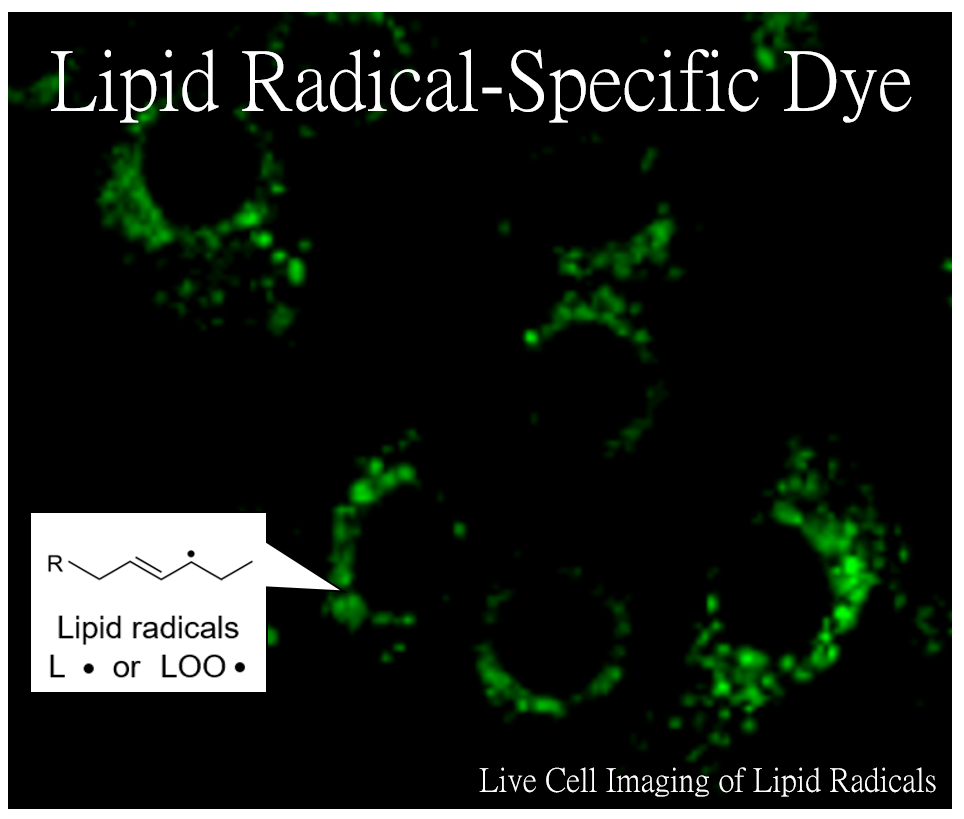
LipiRADICAL™ Green is the world's first detection reagent for lipid radicals, which are upstream factor of lipid-peroxidation (LPO). This reagent is compatible with live cell imaging, structural analysis of lipid radicals by fluorescent LC/MS-MS and etc.
OH-Pen is a specific inhibitor for lipid radical that does not react with other reactive oxygen species. OH-Pen can suppress the LPO signaling via specific reaction with lipid radicals.
Lipid peroxidation (LPO) is one of the several degradation processes of lipids under oxidative stress. Primary products in LPO are lipid radicals and there are two major initiators to induce LPO process.
LPO process (1): Pro-oxidants
For pro-oxidant-induced LPO, lipids containing unsaturated fatty acids, especially polyunsaturated fatty acids (PUFAs), are attacked by pro-oxidants including reactive oxygen species (ROS) and form lipid derived radicals. Lipid radical (L・) can be easily oxidized to lipid peroxyl radical (LOO・). Unstable LOO・ immediately extracts a hydrogen from another lipid molecule generating a lipid hydroperoxide (LOOH) and a new lipid radical (L・).
LPO process (2): Lipid oxidative enzymes
Another pathway enzyme induced LPO, lipids containing PUFAs are oxidized to lipid hydroperoxides (LOOH) which decomposes to lipid peroxyl radicals LOO・ or alkoxyl radicals LO・ by metal ions (Fe 2+ etc.).Once lipid radical is produced by the above two processes, lipid radicals expand the radical chain reaction (radical propagation step). In the termination reaction, antioxidants donate a hydrogen atom to the lipid peroxy radical (LOO・ ) species resulting in the formation of many different aldehydes including malondialdehyde (MDA), acrolein, propanal, hexanal, and 4-hydroxynonenal (4-HNE). These aldehydes are cytotoxic because reactive aldehydes attack biomolecules (proteins, DNA/RNA etc.) to form secondary products. These reactive aldehydes are considered as causative factors of organ injury, ferroptosis and ER stress.
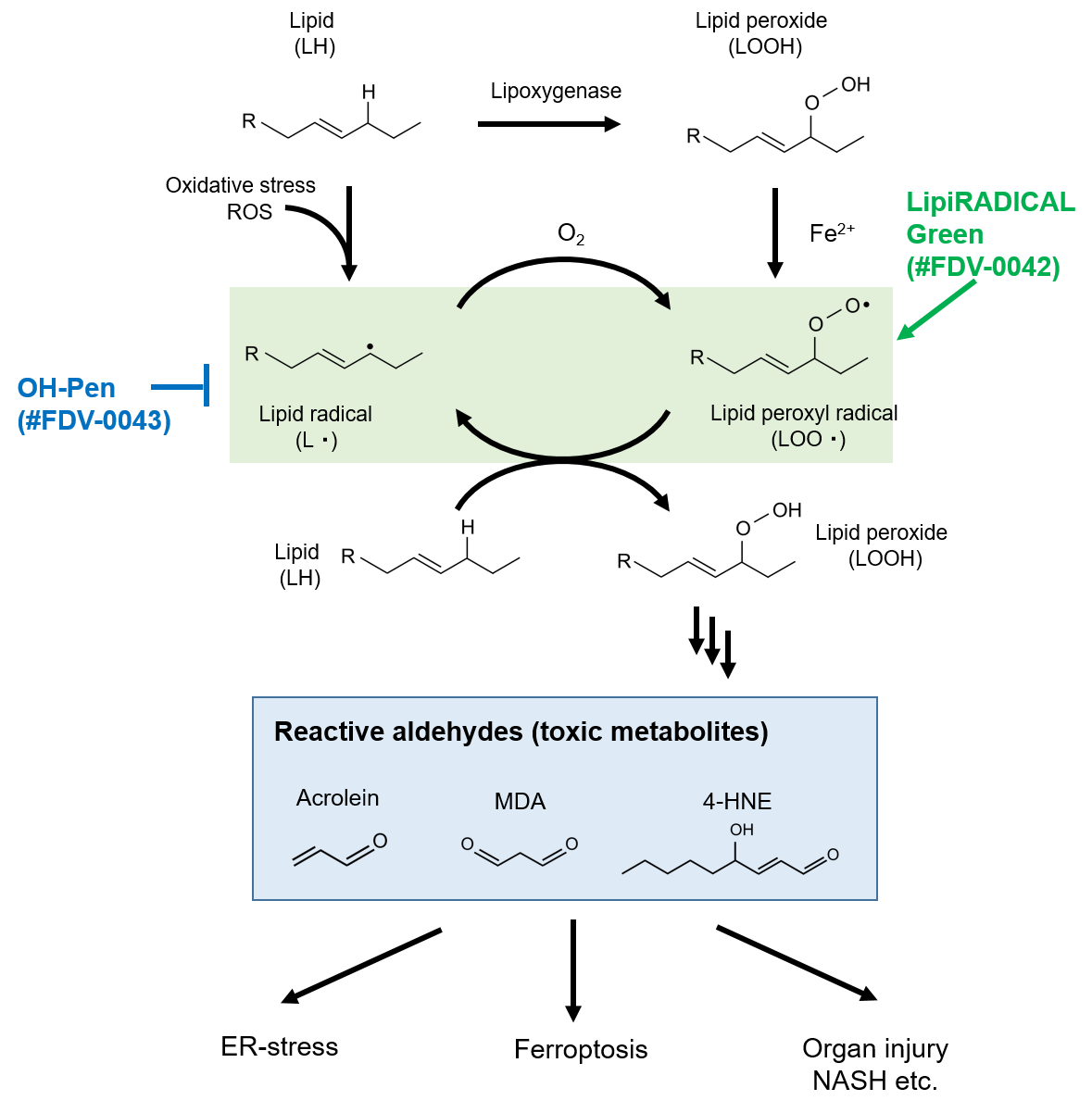
To understand the molecular mechanism and physiological relevance of LPO, detection and quantification methods for lipid radicals are required. The conventional detection methods for lipid radicals are highly limited. For example electron spin resonance (ESR) is a major strategy to detect radical products but not applied to cell based applications.
Background
- Help to understand the molecular mechanism & physiological relevance of LPOLipiRADICAL™ Green is the world’s first lipid radical responsive fluorescent dye. LipiRADICAL™ Green is a green fluorescent dye NBD-conjugated nitroxyl radical-derivative (Below figure). Although this compound contains NBD, the probe ’s fluorescence is highly quenched by intramolecular radical moiety. When the probe reacts with lipid radicals via radical-radical coupling forming a covalent bond to lipids, the fluorescent intensity is drastically recovered. LipiRADICAL™ Green is well validated to selectively detect lipid radicals, not reactive oxygen radicals. LipiRADICAL™ Green enables us to semi-quantification of lipid radicals in biological samples, to image cellular lipid radicals and to identify and analyze the molecular structure of lipid radicals with LC/MS system. LipiRADICAL™ Green is an innovative and powerful tool for LPO research.
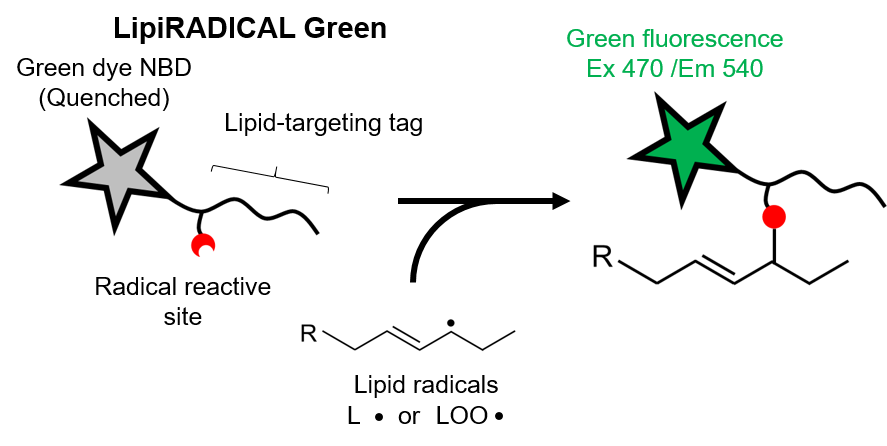 OH-Pen is also powerful tools to research LPO.
This is a unique lipid radical specific inhibitor which will not react with other reactive oxygen species.
OH-Pen has similar structure to LipiRADICAL™ Green; NBD in LipiRADICAL™ Green was just converted to hydroxyl group.
OH-Pen is also powerful tools to research LPO.
This is a unique lipid radical specific inhibitor which will not react with other reactive oxygen species.
OH-Pen has similar structure to LipiRADICAL™ Green; NBD in LipiRADICAL™ Green was just converted to hydroxyl group.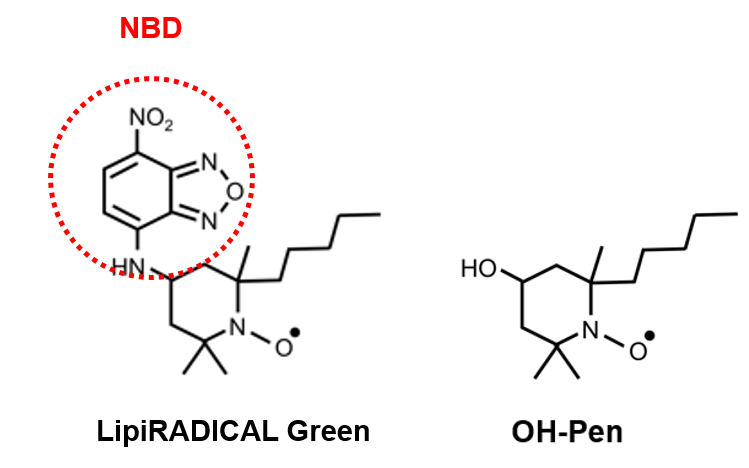
Features
LipiRADICAL™ Green- The reagent itself is highly quenched and shows little fluorescence. After reaction with lipid radicals, it emits green fluorescence in lipid radical dose-dependent manner.
- Ex. / Em. 470 nm / 520-600 nm (max 540 nm); commercial FITC/GFP conditions are compatible.
- Applications
In vitro detection of lipid radicals by fluorescent detection
Live cell imaging of lipid radicals by fluorescent microscopy
Screening of LPO suppressor or anti-oxidant both in vitro and in cellulo
Structural analysis of lipid radicals by fluorescent-LC/MS-MS etc.
- OH-Pen can be used as LPO suppressor via neutralizing lipid radicals
- OH-Pen is a very stable compound though it is a radical compound and can be stably injected into animals
- OH-Pen neutralizes lipid radicals in situ
Appendix: Structural analysis of lipid radicals
Not only detecting lipid radicals in vitro and cells but also LipiRADICAL™ Green applies to the comprehensive identification and structural analysis of lipid radicals. This appendix describes basic instruction for structural analysis of lipid radicals with LipiRADICAL™ Green . Figure A1 shows a diagram of the structural analysis of lipid radicals.
Step-1Fluorescent labeling of lipid radicals by LipiRADICAL™ Green Using any biological samples containing lipid radicals, LipiRADICAL™ Green can label lipid radicals with the NBD fluorescent dye. Lipid fraction is extracted by conventional lipid purification methods such as Bligh/Dyer method.
Step-2Fluorescent LC /MS-MS analysis. The labeled and extracted lipid mixture is applied to liquid chromatography (LC) with fluorescent detection (LC-FL)-high resolution tandem mass spectrometry (HRMS-MS). Labeled lipid-adducts are detected by LC-FL and its mass is detected by HRMS-MS
Step-3Structural estimation. Lipid radical structures are estimated from MS signals detected by LC-FL/HRMS-MS. The theoretical molecular weight of LipiRADICAL™ adduct is 389.2068 (calculated) and the original molecular weight is estimated with the following equation.
[Lipid radical] = [Total MS (detected MS)] – [LipiRADICAL™ adduct (389.2068; calculated)]
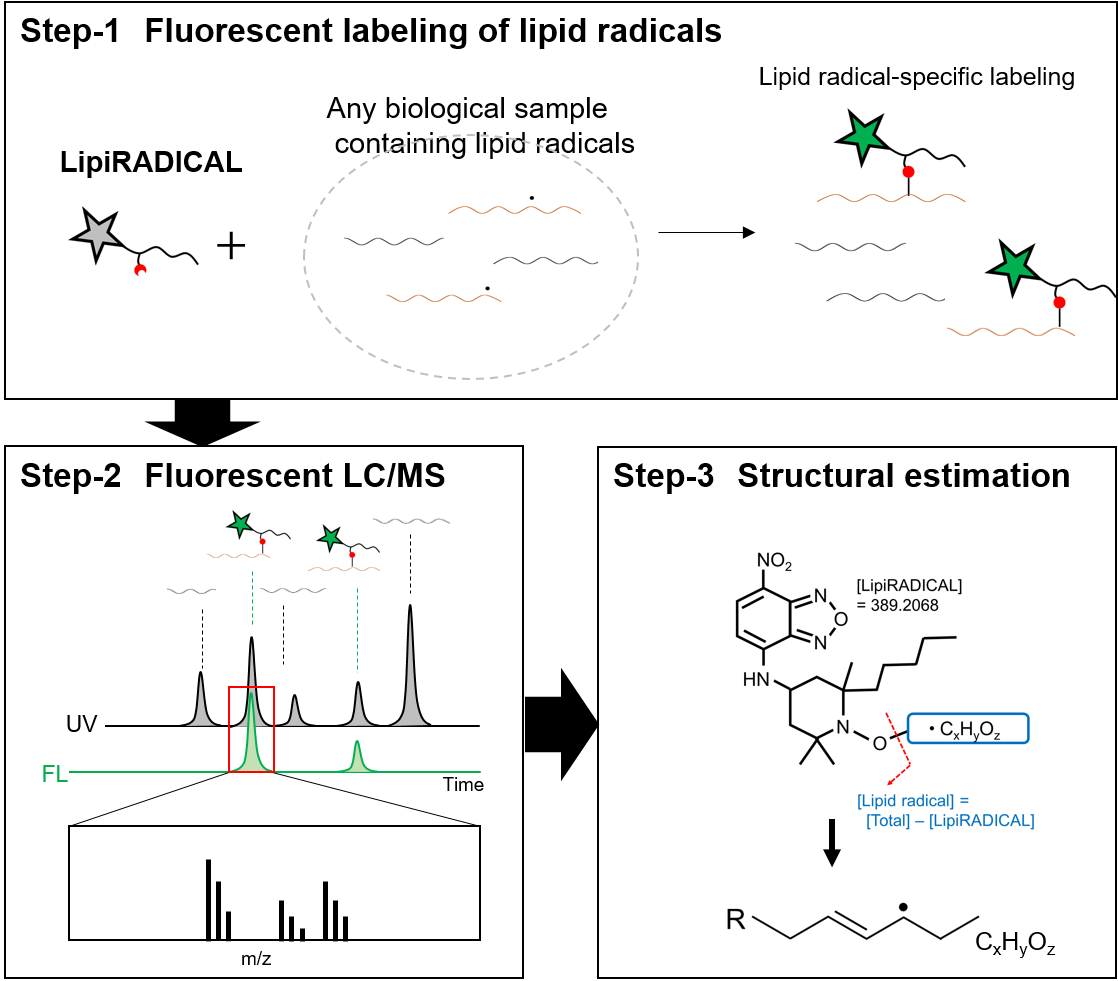
Reference data
Fluorescent spectrum
LipiRADICAL™ Green was added to arachidonic acid-lipoxygenase (LOX) mixtures and observed fluorescence excited by 470 nm light. In the absence of LOX enzyme, the fluorescent signal was highly quenched (Black line). In the presence of LOX enzyme, green fluorescence (500-650 nm, maximum ~540 nm) was detected in LOX dose-dependent manner.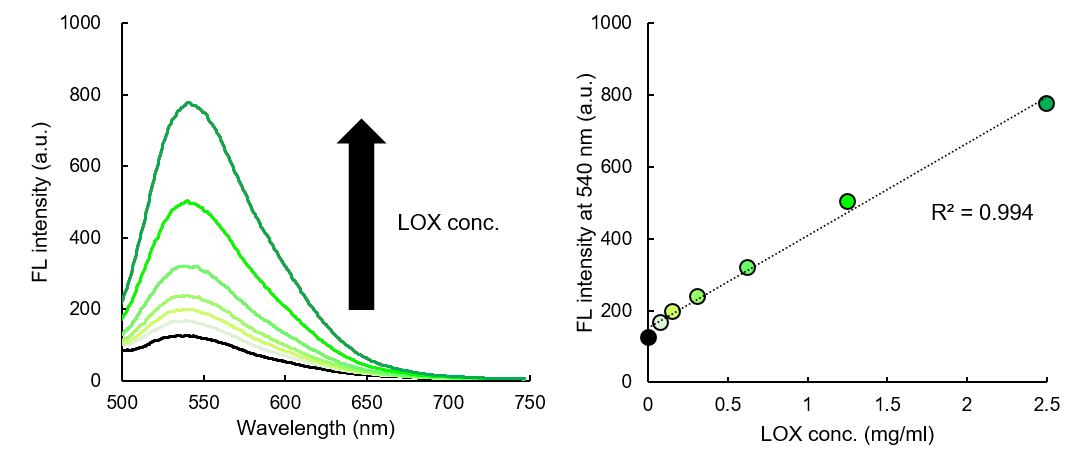
Specificity
LipiRADICAL™ Green was treated with the following reagents and fluorescent intensity (Ex 470 nm/Em 530 nm) was observed. All reactive oxygen species had little effects on the fluorescent intensity of LipiRADICAL™ Green. Green fluorescence was only observed under the polyunsaturated lipids (laulic acid (LA), alpha-laulic acid (ALA) or arachidonic acid (AA)) with LOX enzyme or pro-oxidants including AAPH and MeO-AMVN.Reagents and conditions
LipiRADICAL™ Green (5 μM) H2O2, ClO-, KO2 for O2-・and ・OH : 0.5 mM Lipids (0.5 mM) with LOX (2.5 μg/ml) , AAPH (10 mM) or MeO-AMVN 50 μM
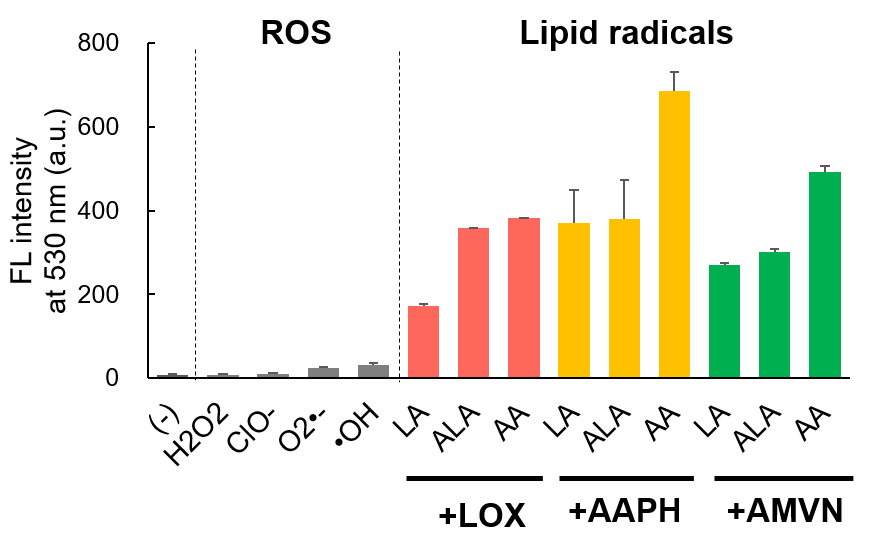
Application data
Cell-based detection of lipid radicals induced by diethylnitrosamine (DEN)
Hepa1-6 cells were treated with 1 μM of LipiRADICAL™ Green for 20 min and washed twice with PBS. For inducing an LPO signal, the cells were co-treated with diethylnitrosamine (DEN) and LipiRADICAL™ Green>, an LPO initiator. Immediately after DEN addition, the cells were observed by confocal microscopy (Ex.458 nm/ Em. 490-674 nm) for 20 min with 2 min interval. The fluorescent signal of LipiRADICAL™ Green from the DEN-treated cells clearly increased.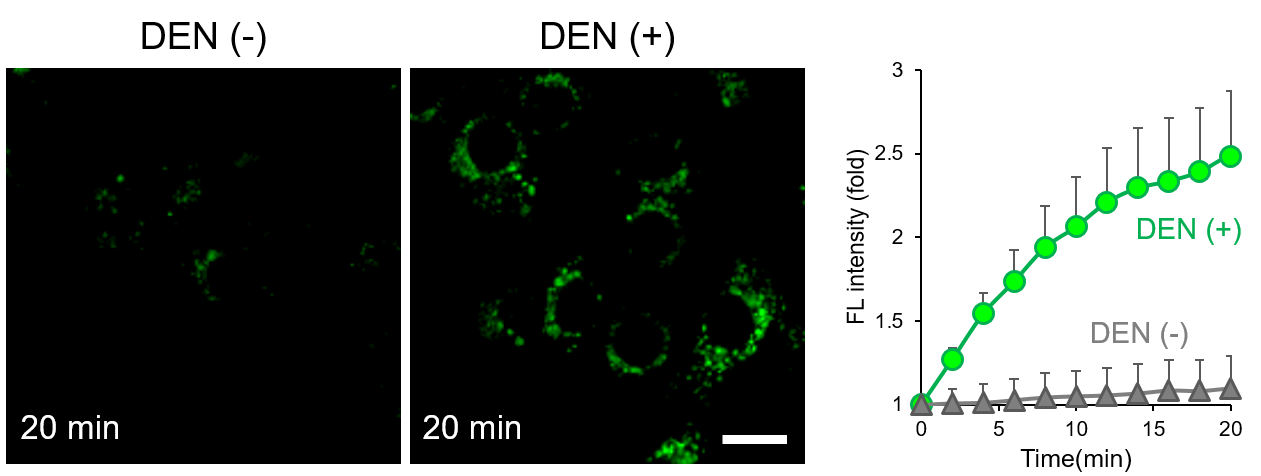
in vitro detection of lipid radicals derived from LDL
Purified low-density lipoprotein (LDL, 20 μg protein/mL) was mixed with pro-oxidants hemin or AAPH and LipiRADICAL™ Green and the green fluorescence (Ex. 470 nm/ Em 530 nm) was measured for 60 min at 37℃. Both hemin and AAPH increased green fluorescence indicating the production of lipid radicals from LDL particles in a time-dependent manner.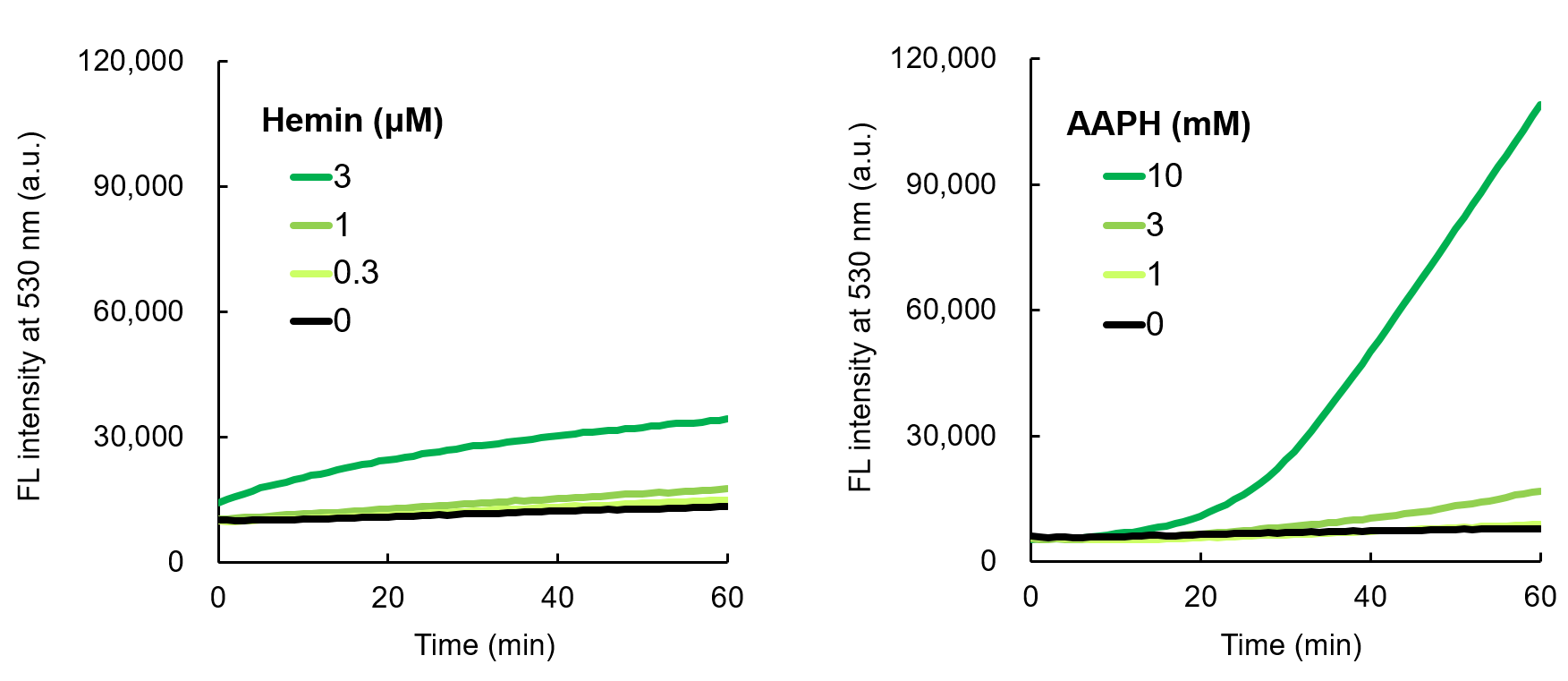
Structural analysis of lipid radicals derived from arachidonic acid in vitro
Arachidonic acid (AA; 500 μM) was incubated with pro-oxidants hemin (10 μM) and AAPH (50 mM) mixture for 60 min. After incubation, 5 μM of LipiRADICAL™ Green was added to the reaction mixture and incubated for 15 min at RT. Lipid components were extracted by the Bligh and Dyer method and analyzed by the LC-FL/MS-MS technique. (Upper panel) The fluorescent chromatogram is shown (Ex. 470/E. 530 nm). Several fluorescent peaks were observed and each peak was further analyzed by MS-MS. (Lower panel) Product profiles of AA-derived radicals are shown. MS-MS analysis identified a total of 8 full-length AA radicals and 29 truncated radicals. The relative abundances of each radical were calculated from each peak area. Detailed experimental protocol and analytical procedure are described in Ref.5.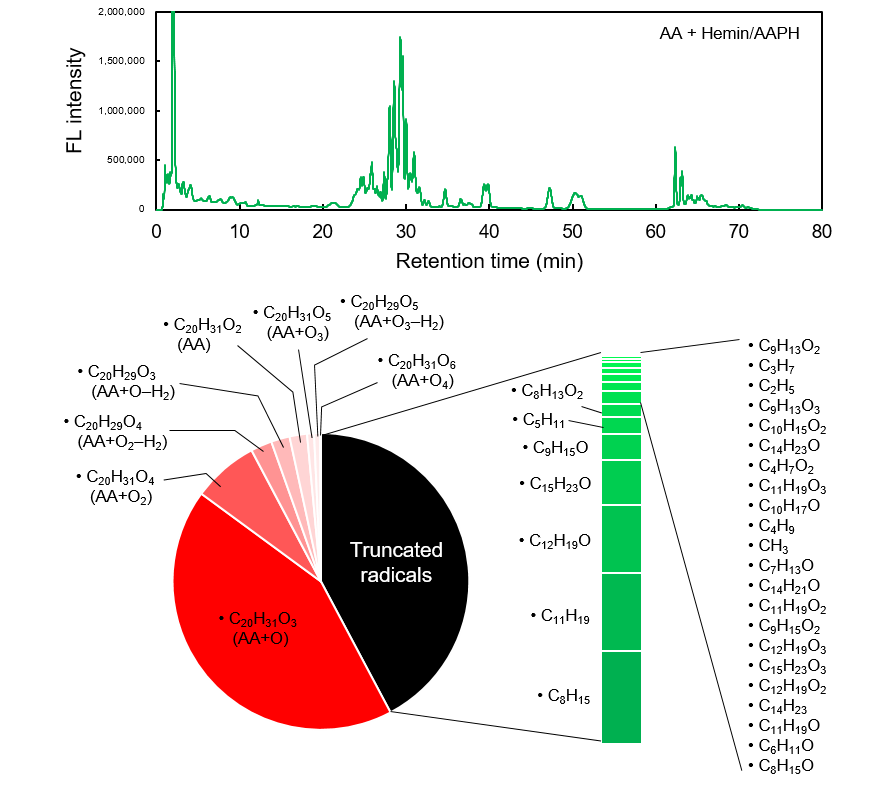
Structural analysis of lipid radicals in vivo
A well-known carcinogen, diethylnitrosamine (DEN, 100 mg/kg body weight), was injected intraperitoneally into mice and after 1, 4 and 24 hours, mice were anesthetized. Anesthetized mice then received intraperitoneal injections of LipiRADICAL™ Green (2.5 μmol/kg body weight). To check the specificity of LipiRADICAL™ Green, OH-Pen, a specific inhibitor of lipid radical (Catalog no. #FDV-0042; 10 μmol/kg body weight) was also injected into the mice before LipiRADICAL™ Green injection. The liver was removed from the mice and homogenized with methanol. Lipid solution was extracted from the liver homogenate according to the Bligh and Dyer method. Lipid samples were applied to LC-FL/MS-MS for analysis (Left). After 4 hours of treatment of DEN, there was a high production of lipid radicals. A total of 11 lipid radicals were identified. (Right) An example, a ・C5H11 radical. OH-Pen-preinjection clearly inhibited the production of lipid radicals derived from DEN treatment.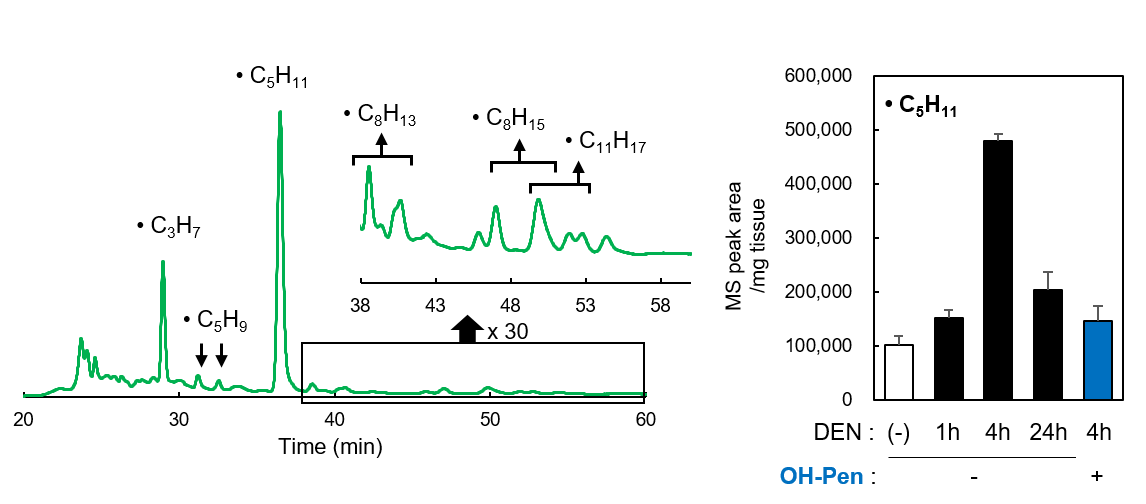
Inhibition of nitrosamine-induced carcinogenesis by OH-Pen
Rats received diethylnitrosamine (DEN, 100 mg/kg body weight), which is a well-known hepatic procarcinogen. Subsequently, rats received OH-Pen (2.5 μmol/kg body weight) by intraperitoneal injection after 1 hour DEN administration. For the acute model and chronic model, livers were dissected after 24 hours and 12 weeks DEN administration, respectively.
(Upper panel) Livers from chronic hepatocelluar carcinoma model and total foci number.
(Middle panel) Quantification of LPO-derived aldehydes in acute model livers.
(Lower panel) Quantification of tissue damage markers.
In all panels, OH-Pen clearly suppressed DEN-induced hepatocellular carcinoma.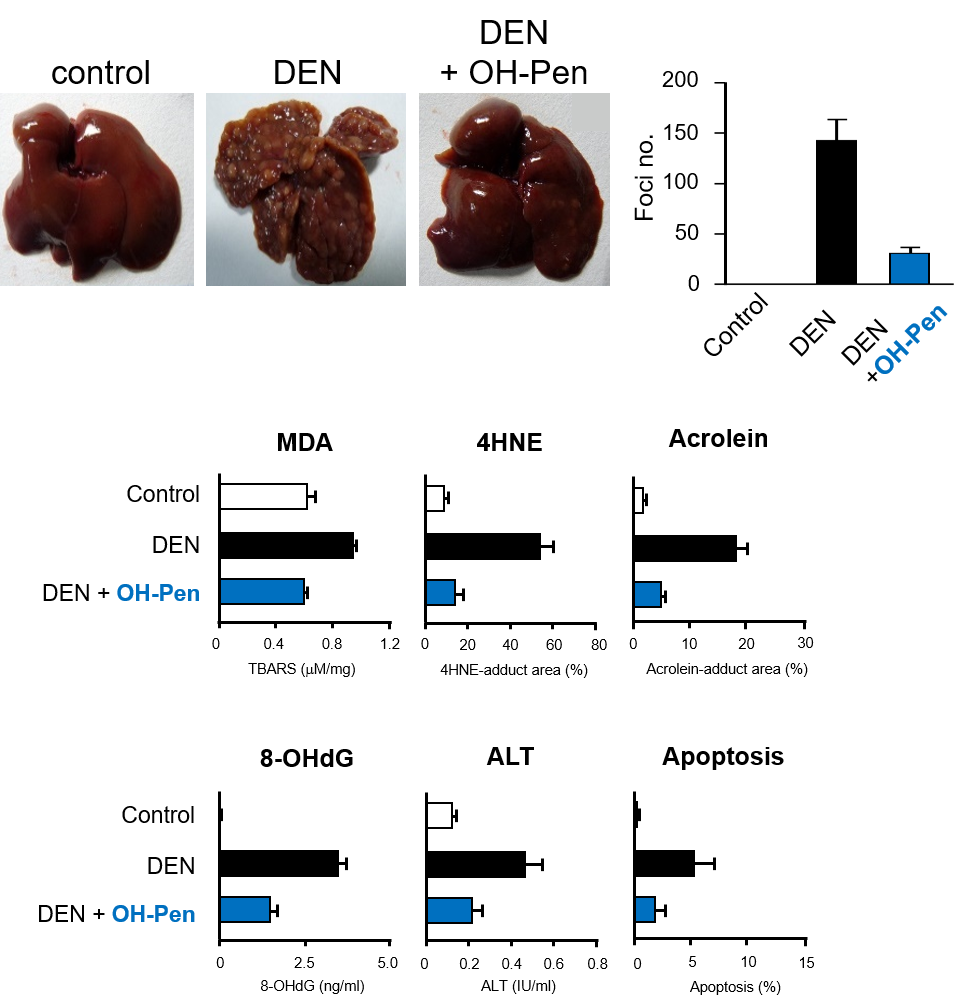
Reference
1. Yamada et al., Nat. Chem. Biol., 12, 608-613 (2016) Fluorescence probes to detect lipid-derived radicals.
2. Enoki et al., Chem. Commun., 53, 10922-10925 (2017) Lipid radicals cause light-induced retinal degeneration.
3. Ishida et al., Free Radical Biol. Med., 113, 487-493 (2017) Detection and inhibition of lipid-derived radicals in low-density lipoprotein.
4. Mishima et al., J. Am. Soc. Nephrol., 31, 280-296 (2020) Drug Repurposed as antiferroptosis agents suppress organ damage, including AKI, by functioning as lipid peroxyl radical scavengers.
5. Matsuoka et al., Anal. Chem., 92, 6993-7002, (2020) Method for structural determination of lipid-derived radicals .
Product Information
[Date : January 22 2026 00:07]
| Detail | Product Name | Product Code | Supplier | Size | Price | ||||||||||||||||||||||||||||||
|---|---|---|---|---|---|---|---|---|---|---|---|---|---|---|---|---|---|---|---|---|---|---|---|---|---|---|---|---|---|---|---|---|---|---|---|
|
LipiRADICAL Green, Lipid Radical Detection Reagent DatasheetThis may not be the latest data sheet. |
FDV-0042 | FNAFunakoshi Co.,Ltd. | 0.1 mg | $380 | |||||||||||||||||||||||||||||||
|
|
|
||||||||||||||||||||||||||||||||||
|
OH-Pen, Lipid Radical Inhibitor DatasheetThis may not be the latest data sheet. |
FDV-0043 | FNAFunakoshi Co.,Ltd. | 0.1 mg | $330 | |||||||||||||||||||||||||||||||
|
|
|
||||||||||||||||||||||||||||||||||
[Date : January 22 2026 00:07]
LipiRADICAL Green, Lipid Radical Detection Reagent
DatasheetThis may not be the latest data sheet.
- Product Code: FDV-0042
- Supplier: FNA
- Size: 0.1mg
- Price: $380
| Description |
LipiRADICAL™ Green is the world's first detection reagent for lipid radicals, which are upstream factor of lipid-peroxidation (LPO). This reagent is compatible with live cell imaging, structural analysis of lipid radicals by fluorescent LC/MS-MS and etc. |
||
|---|---|---|---|
| Storage | -20°C | CAS | |
| Link |
|
||
OH-Pen, Lipid Radical Inhibitor
DatasheetThis may not be the latest data sheet.
- Product Code: FDV-0043
- Supplier: FNA
- Size: 0.1mg
- Price: $330
| Description |
OH-Pen is a specific inhibitor for lipid radical that does not react with other reactive oxygen species. OH-Pen can suppress the LPO signaling via specific reaction with lipid radicals. |
||
|---|---|---|---|
| Storage | -20°C | CAS | |
| Link |
|
||
You may also like
CONTACT
export@funakoshi.co.jp
- ※Prices on our website are for your reference only. Please inquire your distributor for your prices.
- ※Please note that Product Information or Price may change without notice.
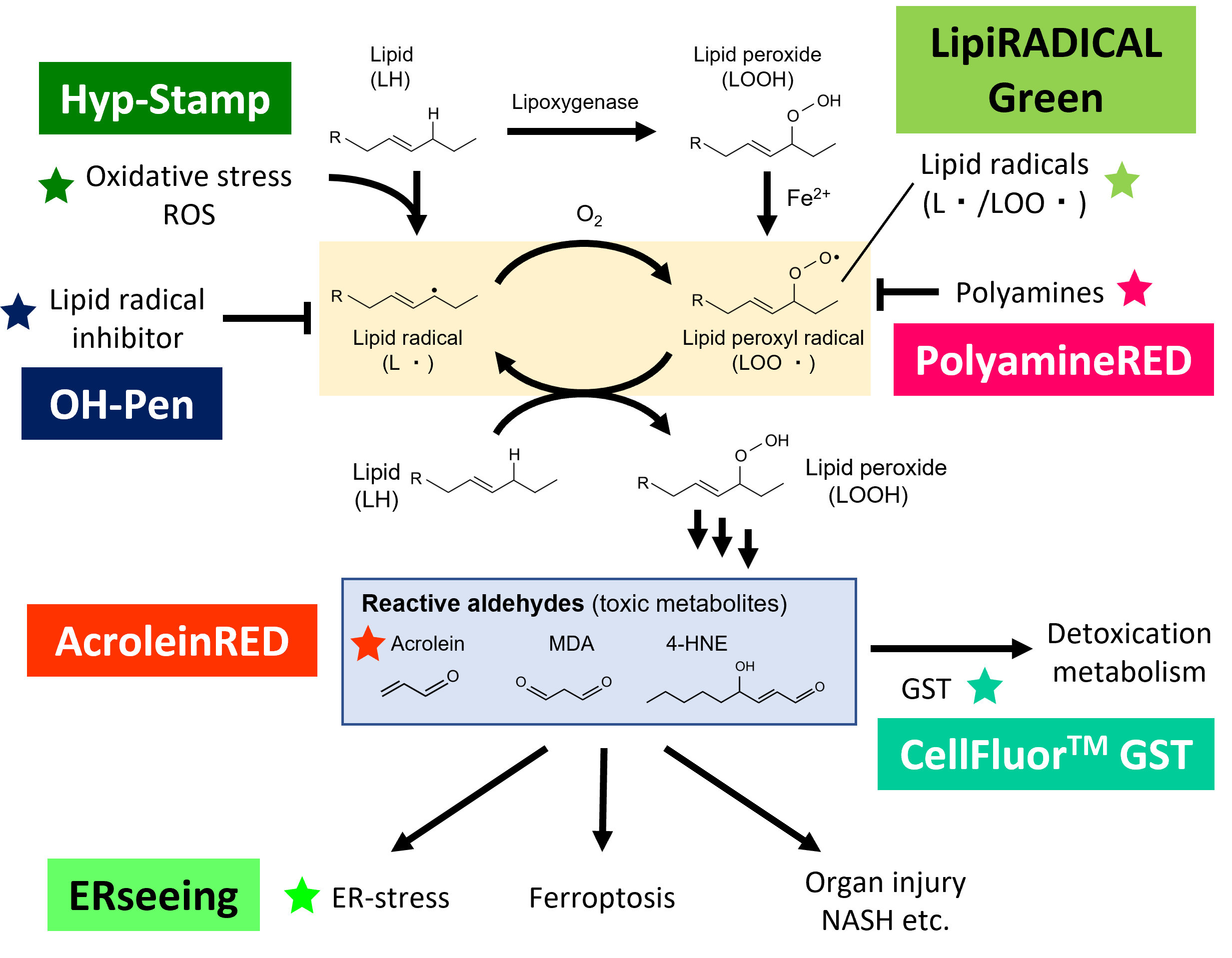
-25-metabolism_map.jpg)